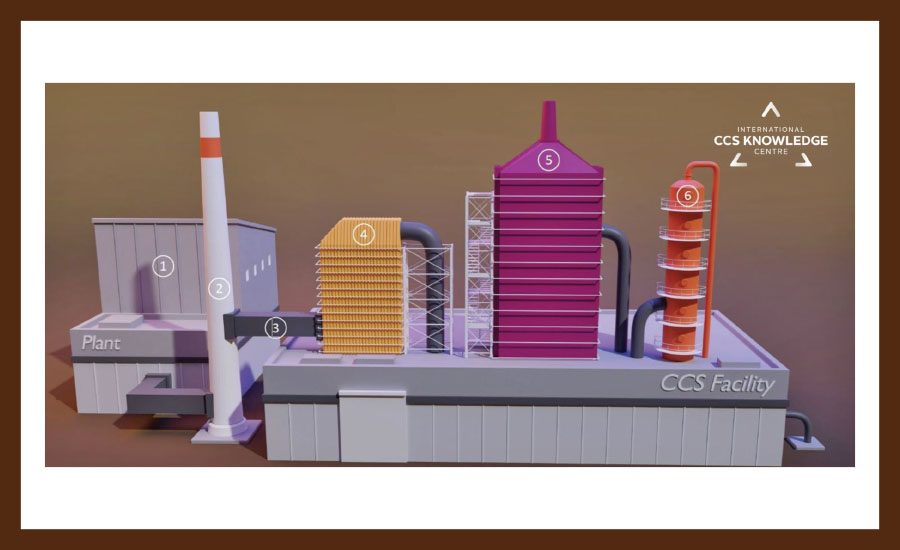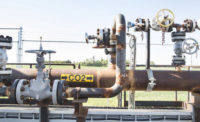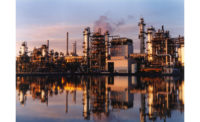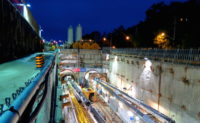A Canadian cement plant could become the world’s first in the construction material production sector to install technology to capture almost all of its carbon emissions and store the compound for potential resale on the market. The planned effort comes amid a growing industry push to eliminate embodied carbon in building materials, particularly concrete made from cement.
Lehigh Cement has launched a feasibility study on a full-scale carbon-capture and storage (CCS) project at its Edmonton, Alberta, plant, working with the International CCS Knowledge Centre to reduce the facility’s greenhouse gas (GHG) emissions. The effort could cost hundreds of millions of dollars.
While there are 18 such large-scale carbon-capture systems in place at industrial sites across the world, none to date have involved cement plants, a major source of GHG. If the project gets the green light, the Lehigh facility would be the first cement plant in Canada and globally to install a commercial-scale carbon capture and storage system.
“Twenty-one percent of the world’s CO2 emissions come from the industrial process, which is dominated by steel and cement,” says Corwyn Bruce, vice president of technical services at the International CCS Knowledge Centre, based at the University of Regina in Regina, Saskatchewan, which is teaming up with Lehigh Cement on the project.
Feasibility Verdict
The $3-million study, which is being partly funded by the Canadian government, is set for completion late next year and will offer a verdict on the feasibility of the project, and, in particular, its financial viability.
The technology itself—which involves diverting and storing hundreds of thousands of tons a year of carbon dioxide—is already in use in a number of coal-fired power plants.
“With this study and global leaders like Lehigh, the application of CCS moves its value beyond coal into cement,” said Beth Hardy, International CCS Knowledge Centre vice president, in a statement. The study will particularly explore whether CCS will be sustainable financially for the plant’s owner, HeidelbergCement Group, based in Heidelberg, Germany, and one of the world’s largest building materials producers. The study will examine the various market uses for the carbon dioxide captured at the plant, including in fertilizer, enhanced oil recovery and even soda.
The carbon capture and storage system would involve funneling the plant’s emissions, typically released into the air, back into a large vessel that would absorb the carbon dioxide. CO2 would then be transferred to a second large vessel, a stripper, where heat would be used to compress the captured CO2 into a nearly liquid form. From there, the CO2 can be either stored for later resale or pumped out through a pipeline to the market.
A carbon trapping system at the Lehigh plant could capture as much as 600,000 tons a year in CO2 , officials estimate. The study will also examine the capital cost of the project. A CCS system at a coal-fired power plant in Houston cost $600 million, while one at a coal-fired plant in Saskatchewan cost more than $700 million, Bruce says.
However, advances in technology have led to a big drop in the cost of construction of such CCS systems, which could mean a significantly lower price tag for installing a system at the Lehigh plant. In fact, there has been more than a 60% reduction in development costs for CCS systems, he contends. If the project gets the green light, the new CCS system would take three to four years to build and install, according to Bruce.
For its part, the cement industry has been aggressive in trying to reduce its carbon footprint, with CCS systems like the one being studied for the Lehigh Cement plant the next big step in this “evolution,” Bruce says. “We are part of HeidelbergCement Group’s vision of CO2 neutral concrete by 2050 and the potential of concrete to become the most sustainable building material,” said Joerg Nixdorf, president, Lehigh Hanson Canada region, in a statement.





